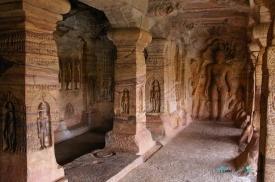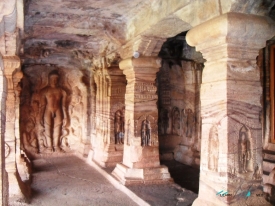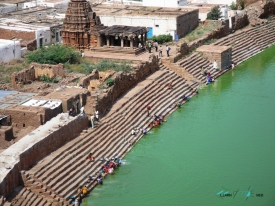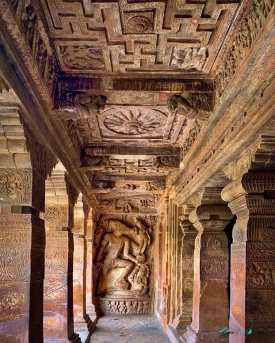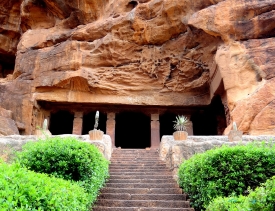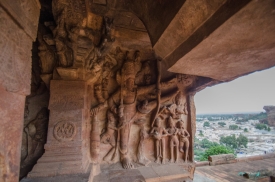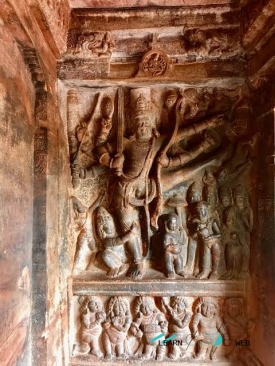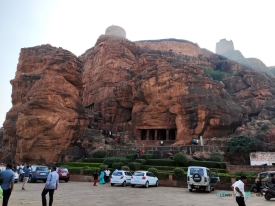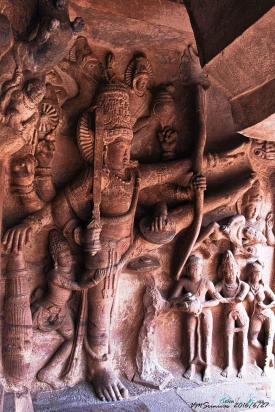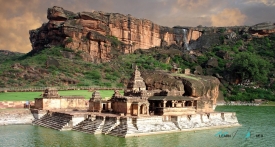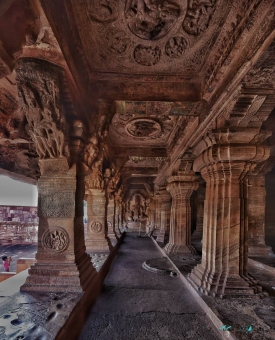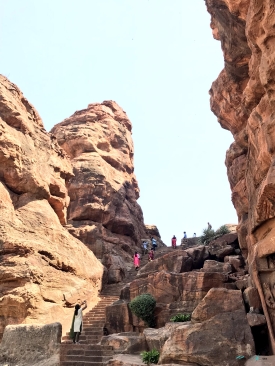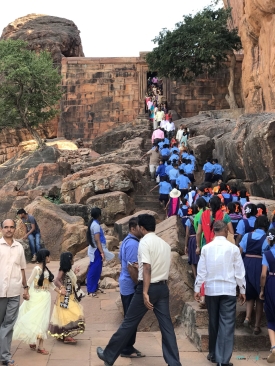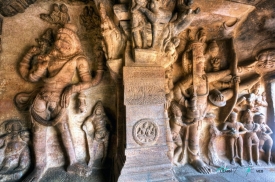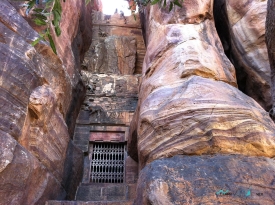Nestled amidst a mesmerizing landscape of sandstone cliffs and lush greenery, the Badami Cave Temples are an awe-inspiring testament to ancient Indian architecture and art. Located in the Bagalkot district of Karnataka, India, this UNESCO World Heritage Site offers a fascinating journey into the past, unveiling the artistic prowess of the Chalukya dynasty. In this comprehensive guide, we'll explore the history, location, and other intriguing aspects of the Badami Cave Temples that make it a must-visit destination for history buffs and travelers alike.
By Air: The nearest airport is in Hubli, about 105 km away. From there, you can hire a taxi or take a bus to Badami.
By Train: The Badami railway station is well-connected to major cities like Bengaluru, Mumbai, and Hyderabad. From the station, hire a taxi or an autorickshaw to reach the cave temples.
By Road: Badami is easily accessible by road from cities like Bengaluru, Pune, and Hyderabad. There are state-run and private buses available or you can rent a car for a more comfortable journey.
The Chalukya dynasty, under the patronage of King Mangalesha, began the construction of the Badami Cave Temples to promote Hinduism and Jainism. The temples are carved out of soft sandstone, which provided the artisans with the flexibility to create intricate sculptures and designs.
The cave temples consist of four main caves, each dedicated to different deities and showcasing distinct architectural styles:
Cave 1: Dedicated to Lord Shiva, this cave boasts an impressive 18-armed Nataraja sculpture, depicting Shiva in his cosmic dance form.
Cave 2: A tribute to Lord Vishnu, this cave showcases stunning sculptures of Vishnu in various avatars, including Varaha and Trivikrama.
Cave 3: The largest and most ornate cave, it features intricately carved sculptures of Vishnu, Shiva, and other deities, along with a Sanskrit inscription detailing the temple's history.
Cave 4: A Jain temple, this cave showcases beautiful carvings of Jain Tirthankaras, including Mahavira and Parshvanatha.
Agastya Lake: A picturesque lake surrounded by the sandstone cliffs, Agastya Lake is believed to possess healing properties. A visit to the Badami Cave Temples is incomplete without witnessing the serene beauty of this lake. The lake is also a great spot for photography, with the vibrant colors of the sandstone cliffs reflecting in the calm waters.
Badami Archaeological Museum: Located close to the cave temples, the Badami Archaeological Museum houses an extensive collection of artifacts, sculptures, and inscriptions from the Chalukya period. Managed by the Archaeological Survey of India, the museum offers a deeper understanding of the history, culture, and artistic achievements of the Chalukya dynasty. The museum is an essential stop for anyone interested in delving further into the rich heritage of the region.
Rock Climbing and Trekking: The rugged sandstone cliffs surrounding the Badami Cave Temples present a unique opportunity for adventure enthusiasts. The cliffs are a popular spot for rock climbing, with several climbing routes available for both beginners and experts. Additionally, trekking in the area allows you to explore the scenic beauty of the region and discover lesser-known historical sites.
Local Cuisine: While visiting the Badami Cave Temples, don't miss the chance to try some traditional North Karnataka dishes. Some popular local delicacies include Jolada Rotti, Yennegai, and Holige. These delicious dishes, made with locally sourced ingredients, offer a true taste of the region's culinary heritage.
Location and How to Get There
The Badami Cave Temples are situated in the town of Badami, approximately 450 km from Bengaluru, the capital of Karnataka. To reach Badami, you can opt for any of the following modes of transport:By Air: The nearest airport is in Hubli, about 105 km away. From there, you can hire a taxi or take a bus to Badami.
By Train: The Badami railway station is well-connected to major cities like Bengaluru, Mumbai, and Hyderabad. From the station, hire a taxi or an autorickshaw to reach the cave temples.
By Road: Badami is easily accessible by road from cities like Bengaluru, Pune, and Hyderabad. There are state-run and private buses available or you can rent a car for a more comfortable journey.
History of Badami Cave Temples
It are constructed out of Badami sandstone and were constructed during the 6th to the 8th century by the Chalukya dynasty. The caves are important examples of Indian rock-cut architecture, especially Badami Chalukya architecture, and the earliest date from the 6th century. The caves represent some of the earliest known examples of Hindu temples in the Deccan region. There are four primary caves, namely, Cave 1, Cave 2, Cave 3 and Cave 4.The Chalukya dynasty, under the patronage of King Mangalesha, began the construction of the Badami Cave Temples to promote Hinduism and Jainism. The temples are carved out of soft sandstone, which provided the artisans with the flexibility to create intricate sculptures and designs.
The cave temples consist of four main caves, each dedicated to different deities and showcasing distinct architectural styles:
Cave 1: Dedicated to Lord Shiva, this cave boasts an impressive 18-armed Nataraja sculpture, depicting Shiva in his cosmic dance form.
Cave 2: A tribute to Lord Vishnu, this cave showcases stunning sculptures of Vishnu in various avatars, including Varaha and Trivikrama.
Cave 3: The largest and most ornate cave, it features intricately carved sculptures of Vishnu, Shiva, and other deities, along with a Sanskrit inscription detailing the temple's history.
Cave 4: A Jain temple, this cave showcases beautiful carvings of Jain Tirthankaras, including Mahavira and Parshvanatha.
Other interesting places near the caves
The Bhutanatha Group of Temples: Located near the Badami Cave Temples, these temples are dedicated to Lord Shiva and provide an insight into the architectural transition from the Chalukya to the Hoysala period. Visitors can appreciate the delicate carvings and sculptures that adorn these temples, as well as enjoy the serene ambiance by the waters of Agastya Lake.Agastya Lake: A picturesque lake surrounded by the sandstone cliffs, Agastya Lake is believed to possess healing properties. A visit to the Badami Cave Temples is incomplete without witnessing the serene beauty of this lake. The lake is also a great spot for photography, with the vibrant colors of the sandstone cliffs reflecting in the calm waters.
Badami Archaeological Museum: Located close to the cave temples, the Badami Archaeological Museum houses an extensive collection of artifacts, sculptures, and inscriptions from the Chalukya period. Managed by the Archaeological Survey of India, the museum offers a deeper understanding of the history, culture, and artistic achievements of the Chalukya dynasty. The museum is an essential stop for anyone interested in delving further into the rich heritage of the region.
Rock Climbing and Trekking: The rugged sandstone cliffs surrounding the Badami Cave Temples present a unique opportunity for adventure enthusiasts. The cliffs are a popular spot for rock climbing, with several climbing routes available for both beginners and experts. Additionally, trekking in the area allows you to explore the scenic beauty of the region and discover lesser-known historical sites.
Local Cuisine: While visiting the Badami Cave Temples, don't miss the chance to try some traditional North Karnataka dishes. Some popular local delicacies include Jolada Rotti, Yennegai, and Holige. These delicious dishes, made with locally sourced ingredients, offer a true taste of the region's culinary heritage.



